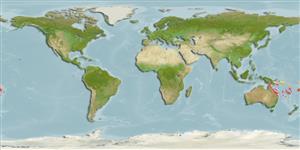>
Eupercaria/misc (Various families in series Eupercaria) >
Labridae (Wrasses) > Corinae
Etymology: Thalassoma: Greek, thalassa = the sea + Greek, soma = body; the colour of the sea (Ref. 45335); nigrofasciatum: Name from Latin, referring to the presence of black bars on the body.
More on author: Randall.
Environment: milieu / climate zone / εύρος βάθους / distribution range
Οικολογία
Θαλασσινό(ά) Υφαλόφιλο(α); εύρος βάθους 0 - 15 m (Ref. 57555). Tropical; 7°S - 32°S, 142°E - 173°W
Western Pacific.
Μέγεθος / Βάρος / Age
Γεννητική Ωρίμανση: Lm ? range ? - ? cm
Max length : 20.0 cm SL αρσενικό/απροσδιόριστο; (Ref. 57555)
Short description
Κλείδες προσδιορισμού | Μορφολογία | Μορφομετρία
Ραχιαίες άκανθες (συνολικά) : 8; Μαλακές ραχιαίες ακτίνες (συνολικά) : 13; Εδρικές άκανθες: 3; Μαλακές εδρικές ακτίνες: 11; Σπόνδυλοι: 25. Diagnosis: Dorsal rays VIII,13. Anal rays III,11, the first spine, when detectable is very slender and short. Pectoral rays 15-16 (usually 15). Lateral line scales 26-27. Head naked, except for a small patch of scales dorsally on opercle. Gill rakers 20-23. Body depth 5.9-3.6 in SL; head length (HL) 3.1-3.4 in SL; snout length 8.4-9.8 in SL; caudal peduncle depth 6.2-6.65 in SL; pectoral fins 4.0-4.3 in SL; pelvic fins 6.3-6.9 in SL. The caudal fin is truncate in young individuals, becoming strongly lunate with filamentous lobes in adult males. The initial phase is white with postorbital head and anterior body above pectoral-fin base black with an oblique yellow band above dorsal edge of opercle, a black bar over last 4 or 5 dorsal spines continuing ventrally across body, its posterior edge vertical, and a broader black bar over last 9 soft rays of dorsal fin, across the body, and posterior anal fin; a black spot on first 2 membranes of dorsal fin; the terminal males with yellow partly replacing the white, a salmon pink patch on chin, and blue ventrally on head and chest (Ref. 57555).
Body shape (shape guide): fusiform / normal.
Found solitary or in groups, most commonly on outer reef areas, and also found in coastal reefs, lagoons and tide pools (Ref. 57555, 90102).
Life cycle and mating behavior
Γεννητική Ωρίμανση | Αναπαραγωγή | Γεννοβολία | Αβγά | Γονιμότητα | Προνύμφες
Oviparous, distinct pairing during breeding (Ref. 205).
Randall, J.E., 2003. Thalassoma nigrofasciatum, a new species of labrid fish from the south-west Pacific. aqua, J. Ichthyol. Aquat. Biol. 7(1):1-8. (Ref. 57555)
IUCN Red List Status (Ref. 130435: Version 2025-1)
Threat to humans
Harmless
Human uses
Εργαλεία
Special reports
Download XML
Διαδικτυακές πηγές
Estimates based on models
Preferred temperature (Αναφ.
123201): 24.6 - 28.5, mean 26.6 °C (based on 405 cells).
Phylogenetic diversity index (Αναφ.
82804): PD
50 = 0.5000 [Uniqueness, from 0.5 = low to 2.0 = high].
Bayesian length-weight: a=0.00977 (0.00430 - 0.02222), b=3.05 (2.88 - 3.22), in cm total length, based on LWR estimates for this Genus-body shape (Ref.
93245).
Τροφικό Επίπεδο (Αναφ.
69278): 3.5 ±0.4 se; based on size and trophs of closest relatives
Ελαστικότητα (Αναφ.
120179): Μεσαίο(α), ελάχιστος χρόνος για διπλασιασμό πληθυσμού 1,4 - 4,4 έτη (Preliminary K or Fecundity.).
Fishing Vulnerability (Ref.
59153): Low vulnerability (14 of 100).
🛈
Nutrients (Ref.
124155): Calcium = 72.3 [42.9, 120.5] mg/100g; Iron = 0.646 [0.373, 1.205] mg/100g; Protein = 18.5 [15.6, 20.7] %; Omega3 = 0.138 [0.088, 0.214] g/100g; Selenium = 20.6 [12.2, 37.3] μg/100g; VitaminA = 145 [44, 526] μg/100g; Zinc = 1.63 [1.14, 2.59] mg/100g (wet weight);
